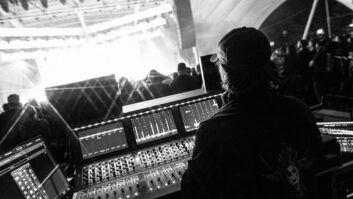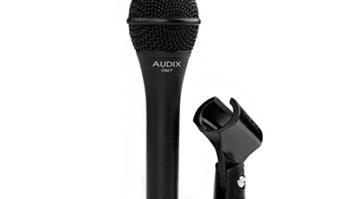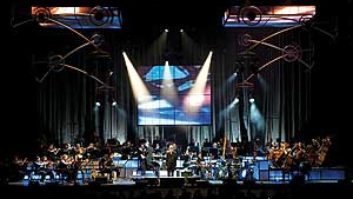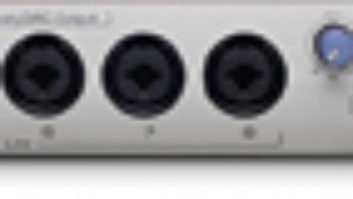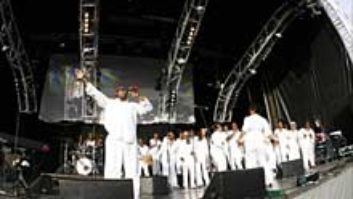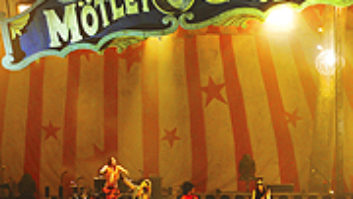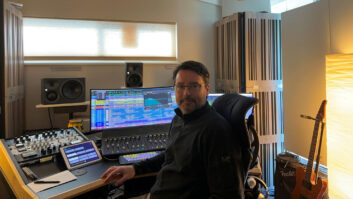Against Me’s longtime live engineer, Marc Hudson, tackles the house mix, monitor fold-back and recording 32 channels nightly. AMITYVILLE, NY—Known for a potent mix of punk and folk that sounds equally at home in intimate venues and stadium festivals, Against Me spent the summer on a headlining club tour, playing a variety of spaces including Long Island’s Club Revolution in Amityville, NY. Manning the desk at every stop was the band’s longtime audio engineer, Marc Hudson.

The group’s new album, Transgender Dysphoria Blues, is one of Against Me’s angriest to date. While that aggression translates to the live stage, Hudson doesn’t feel a burden to maintain the sound of the band’s albums to such a methodical degree. “I’m not trying to match those particular records the way they were captured, because that was just one moment of capturing those songs,” he said. “That is not the only way those songs exist. The sound live is how the songs sound now; each of those records was a different sort of view on trying to capture that song at the time. That, to me, is different than what’s happening at a show. Some bands, that’s part of their sound, [but] Against Me has always been a very stark punk rock band.”
If bringing across a song’s current sound is second-nature to Hudson, that might because he has a lot of practice, as he has been pulling triple duty as FOH engineer, monitor engineer, as well as recording songs nightly for an upcoming live album, tackling all three simultaneously on an Avid S3L supplied by Clair (Lititz, PA). “We doing FOH and monitors off of that and also recording a live album, because it can do up to 64 tracks off an Ethernet cable to a laptop. It’s simple, very all-in-one and it’s working great, been super-solid. We have two stage boxes; each one has 16 I/Os so we have 32 inputs total. I’m using just about every input and output that it has. I split the inputs to add another layer for the monitors, just to keep them separate, so I’m doing everything the console can do and so far, it hasn’t flinched.” Clair not only supplied him with the Avid; it built him a special case for it as well: “Everything’s kind of done—I lift it up and it’s pretty much ready to go. I saves me a lot of time, which is great since I’m tour manager as well.”
Handling three desks’ worth of mixing on the S3L was a tidy arrangement, as the band was mostly playing clubs, using venue-supplied wedges; in Club Revolution’s case, that meant JBL 15-inch two-ways and double 15-inch sidefills, along with a power 18-inch sub and powered 12-inch two-way for the drum monitors. All that led to Hudson creating that second monitor layer on the S3L and driving the house wedges with the resultant mixes.
The Avid S3L system at the heart of the Against Me mix position. Club Revolution uses Sennheiser and Shure as its house microphones, which fit well with Hudson’s penchant for Sennheisers, such as the e935s used for all the band’s vocals. “They seem a little more hi-fidelity and they’re relatively controllable on the monitors,” he said. Hudson tends to get crafty with his mic setup, especially with the Beyer M-260 Ribbon that he uses for the drums. Initially using it just for recording, Hudson began adding it into the band’s live sound to bring more heft to the drums, placing it strategically between all four drum shells. “It’s a hypercardioid,” Hudson explains, “which is nice because it doesn’t get a lot of the cymbals above it; it zeroes right in on the shells.”

Grabbing the band’s guitar sound live, he pairs a mic with a Palmer DI off the cabinet: “I do one guitar player’s DI left and his mic to the right, and the other guitar player is the opposite. The way that works out is that if someone in the crowd is standing toward the left side, they’re hearing the DI from one guitar player and mic from the other guitar player. Since it’s a DI, the sensation is that it’s a little closer to you, so the other guitar player is a little bit more back, and the levels are separated sonically, and if you’re in the center, you get a nice little spread because of that time delay.”
Hudson’s overhead miking practices have been known to turn a few heads, too. “House guys always end up asking about the way I run my overheads, which is actually as underheads. That started years ago when Against Me was doing smaller shows in Europe and they would allow the crowd to get up on stage; my overhead stands would get knocked over a lot by rowdy crowds,” he recalled. “I had to start clamping down everything I could—basically I did everything except for vocals. I did a few recordings that way to hear the results and see how well it worked to have the mics clamped on. The distance from the cymbals is the same as it would be with the overhead, so the sound is almost exactly the same, it has a clean look on stage, and during festivals, if you have to do a quick change, the mics are already on stands so you just have to slide them over. It saves some time and doesn’t sound any different—still sounds great.”
That careful miking resulted in a great punk rock show at Revolution. Against Me sounded solid coming from the club’s Crown and QSC-powered house system, a mix of Smith Audio 1230 three-ways and JBL 18-inch subs. While audience members jumped on- and offstage throughout the show, the band maintained its sonic force—all in all, a far cry from a night in Eastern Europe on a tour years ago where Hudson wound up literally holding everything together: “The sound system is a little 4-channel mixer and one, maybe two speakers,” he reminisced. “The FOH position is on the side of the stage, and the second the first song starts, the whole crowd’s on the stage. The band crowds around the drummer, mic stands crowded against the drum kit, so they’re held up. The whole show is like that and I’ve got one arm wrapped around the vocal cabinet, just trying to keep vocals running. And it was awesome! I had no problem with that—those shows were amazing, but it was definitely a different end of the spectrum.”
Against Me
Againstme.net
